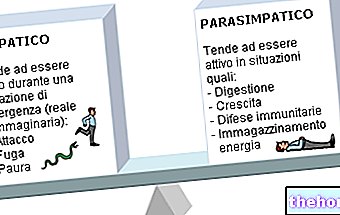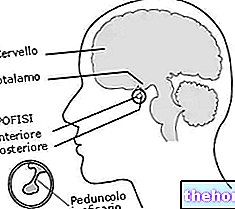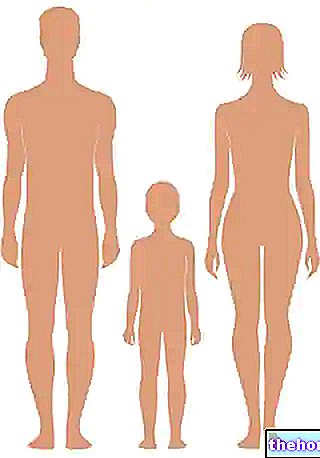Amino acids and proteins are the intermediates of passage from the mineral world to living matter.
As their name indicates, amino acids are bifunctional organic substances: consisting of the amino function (-NH2) and the carboxyl function (-COOH); they can be α, β, γ, etc., depending on the position occupied by the amino group in relation to the carboxy group:



The biologically important amino acids are all α-amino acids.
The protein structures are made up of twenty amino acids.
As can be seen from the generic structures shown above, amino acids all have a common part and a different part that characterizes them (represented generically with R).
Of the twenty amino acids, nineteen are optically active (they deflect the plane of polarized light).
Most amino acids have only one amino group and one carboxyl therefore they are called neutral amino acids; those that have an extra carboxyl are called acid amino acids while those with an extra amino group are basic amino acids.
Amino acids are crystalline solids and have good water solubility.
The lack of some amino acids in the diet causes serious changes in development; in fact, the human organism is not able to synthesize some amino acids which are precisely called essential (they must be introduced with the diet), while it can produce by itself only some amino acids (the non-essential ones).
One of the diseases due to the lack of essential amino acids is the one known by the name kwashiorkor (a word that comes from an African dialect which translated means "first and second"); this disease affects the first-born but after the birth of the second child because the first one lacks the mother's milk which contains the correct supply of proteins. This disease, therefore, is widespread among undernourished populations and involves diarrhea, a lack of appetite which leads to a progressive weakening of the organism.
As already mentioned, natural amino acids, with the exception of glycine (it is an a-amino acid with a hydrogen instead of the R group and is the smallest of the twenty), possess optical activity due to the presence of at least one asymmetric carbon. In natural amino acids the absolute configuration of the asymmetric carbon on which only the amino and carboxy groups are linked belongs to the L series;
D-amino acids never become part of the structure of a protein.
We remember that:
DNA ---- transcription → m-RNA ---- translation → protein
The transcription is capable of coding as L-amino acids; D-amino acids can be contained in non-protein structures (eg. in the lining wall of bacteria: in bacteria there is no "genetic information for having D-amino acids for a protective role, however, there is" genetic information for enzymes which deal with the bacterial lining wall).
Let's go back to amino acids: the different structure of the R group defines the individual characteristics of each amino acid and makes a specific contribution to the characteristics of proteins.
It was therefore thought to divide amino acids based on the nature of the R group:
Polar but uncharged amino acids:
Glycine (R = H-)
Serine (R = HO-CH2-)
Threonineessential
Threonine has two centers of symmetry: only 2S, 3R threonine exists in nature.
Threonine is an essential amino acid (not to be confused with indispensable: all amino acids are essential), so it must be taken with the diet, i.e. by eating foods that contain it because, as already mentioned, the genetic heritage is not present in the cells of human beings. able to produce this amino acid (this heritage is present in many plants and betters).
The hydroxyl group of serine and threonine can be esterified with a phosphoryl group (obtaining phosphoserine and phosphotreonine), this process is called phosphorylation; phosphorylation is used in nature for the translation of signals between the inside and outside of the cell.
Cysteine (R = HS-CH2-)
The sulfhydryl of cysteine is more easily protonable than the hydroxyl of serine: sulfur and oxygen are both of the sixth group but sulfur is more easily oxidizable because it has larger dimensions.
Tyrosine [R = HO- (C6H4) -CH2-]
N.B.
(C6H4) = di-substituted benzene ring
As with serine and threonine, hydroxyl can be esterified (phosphorylated).Asparagine (R = NH2-CO-CH2-)
Glutamine (R = NH2-CO-CH2-CH2-)
Non-polar amino acids
have hydrophobic side groups; within this class we distinguish:
Aliphatics:
Alanine (R = CH3-)
Valine (R = (CH3) 2-CH-) essential
Leucine (R = (CH3) 2-CH-CH2-) essential
Isoleucine (R =
) essential
Methionine (R = CH3-S-CH2-CH2-) essential
Cell membranes are made up of a lipid bilayer with proteins anchored thanks to their hydrophobic character, therefore they contain alanine, valine, isoleucine and leucine. Methionine, on the other hand, is an amino acid almost always present in small quantities (about 1%).
Proline
Aromatic:
Phenylalanine (R = Ph-CH2-) Ph = phenyl: essential monosubstituted benzene
Tryptophan (R =
essential
These two amino acids, being aromatic, absorb near ultraviolet radiation (about 300 nm); therefore it is possible to exploit the technique of UV spectrophotometry to determine the concentration of a known protein that contains these amino acids.
Charged amino acids
In turn they are divided into:
Acidic amino acids (having polar residues with negative charge at pH 7) are such because they are able to yield a positive H + charge:
Aspartic acid
Glutamic acid (R =
)
These amino acids derive from asparagine and glutamine respectively; all four exist in nature and this means that c "is a specific information for each of them, that is c" is a triplet of bases in the DNA that codes for each of them.
Basic amino acids (having polar residues with a positive charge at pH 7) are such because they are able to accept a positive H + charge:
Lysine (R =
) essential
Arginine (R =
)
Histidine (R =
)
There are proteins in which there are derivatives of amino acids in the side chains: for example, a phosphoserine may be present (there is no genetic information that codes for phosphoserine, only that for serine); phosphoserine is a modification post-translational: after protein synthesis has occurred
DNA ---- transcription → m-RNA ---- translation → protein
such post-translational modifications can occur on the side chains of the protein.
See also: Proteins, a look at chemistry





































